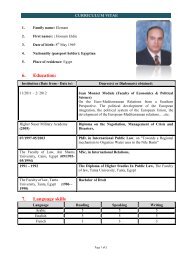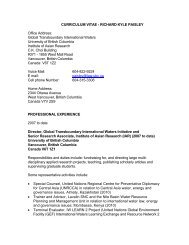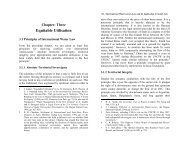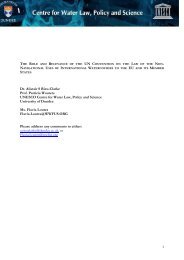Upreti, Trilochan, International Watercourses Law and Its Application ...
Upreti, Trilochan, International Watercourses Law and Its Application ...
Upreti, Trilochan, International Watercourses Law and Its Application ...
Create successful ePaper yourself
Turn your PDF publications into a flip-book with our unique Google optimized e-Paper software.
282 / <strong>International</strong> <strong>Watercourses</strong> <strong>Law</strong> <strong>and</strong> <strong>Its</strong> <strong>Application</strong> in South Asia Conclusions <strong>and</strong> Recummendations / 283the cornerstone of resolution of the issues on shared naturalresources, including shared watercourses. 12 The tremendoussuccess in new technological innovations has the potential tohelp avert conflicts. Examples are, re-use of water, 13 distillationtechnology, <strong>and</strong> technologies to deliver water over greatdistances. Some ambitious propositions that can be cited in thiscontext are: Turkey’s plan to deliver waters to the wholeMiddle East, cloud shedding <strong>and</strong> unnatural precipitationprogrammes as undertaken presently in the US <strong>and</strong> Israel,potential water delivery, <strong>and</strong> use of Antarctica's <strong>and</strong> also thehigh Himalaya's waters. 14Chapter four dealt with the issues of Nepal <strong>and</strong> regional cooperationin south Asia. It assessed the problems <strong>and</strong> prospects,<strong>and</strong> suggested measures to solve problems in such a way thatevery nation can win <strong>and</strong> no one loses. 15 A historicalperspective on bilateral relations, <strong>and</strong> water relations inparticular have been given <strong>and</strong> evaluated in the light of presentchallenges. The potential benefits to Nepal, India, Bangladesh<strong>and</strong> Bhutan in bilateral <strong>and</strong> regional perspectives are verypromising. However, the reality <strong>and</strong> the existing framework ofco-operation is far from satisfactory. 16 There are opportunitiesfor numerous trade-offs amongst these nations, whereby themisery of poverty could be overcome by prosperity within the12 S. C. McCaffrey <strong>and</strong> M. Sinzela, “The United Nations Convention on<strong>International</strong> <strong>Watercourses</strong>” (1998) 92 AJIL, p. 106.13 Singapore is planning to substitute at least 2% of imported water byrecycling waste water by the year 2004,www.internationalwaterlaw.org.14 R. Clarke, Water: The <strong>International</strong> Crisis, London: Earthscan Pub.,1991, p.110.15 B. Subba, Himalayan Waters, Kathm<strong>and</strong>u: Panos South Asia, 2001, p225; also see B. G.Vershese, “Regional Cooperation for Optimal Basin Development” inB. G. Verghese & R. R. Iyer (eds) Harnessing the Eastern HimalayanRivers: Regional Cooperation in South Asia, New Delhi: Konark Pub.,1994, pp. 263-280.16 S. D. Muni, India <strong>and</strong> Nepal: A Changing Relationships, New Delhi:Konark Pub., 1996, pp. 161-176.framework of the concept of, ‘dependence withininterdependence’. 17 Past experiences have been marred byconfrontation rather than improved by meaningful co-operation.Such attitudes, however, appear to be changing, most recentlyin the Nile basin 18 <strong>and</strong> south Asia. 19 It is essential to takeadvantage of such a positive situation. 20 As a result of pastrelations shrouded by the miasma of negative attitudes ofsuspicion, each state is cautious <strong>and</strong> doubtful of the other. 21This research has indicated the implications of co-operation.For its achievement, however, a radical change in working aswell as in thinking is urgently required <strong>and</strong> the leaders of thisregion must undertake radical change with charismaticleadership. 22Chapter five has demonstrated the legal issues involved in theRiver-Linking Project of India, its relevance to get rid ofrecurrence flood, drought <strong>and</strong> famine, potential advantage fromthe project to India <strong>and</strong> her neighbours <strong>and</strong> the role of regionalcooperation. The best way to tackle the poverty in south Asiahas been is depend how states can cooperate with others,underst<strong>and</strong> other sensivity <strong>and</strong> how law help them toimplement this huge project.6.3 Implications of Water ScarcityThe alarming increase of the world’s population poses a threatto the maintenance of the availability <strong>and</strong> distribution of these17 B. C. <strong>Upreti</strong>, Politics of Himalayan River Waters, New Delhi: NiralaPub., 1993, pp. 158-178.18 Supra note 9, p. 159.19 The Power Purchase agreement on west the Seti project <strong>and</strong> the riverLinking Project are evidence of it.20 S. P. Subedi, “The Hydro Politics of South Asia: the Conclusion of theMahakali <strong>and</strong> Ganges River Treaties” (1999) 93 AJIL, p. 962.21 B. Crow, A. Lindquist & D. Wilson, Sharing the Ganges: the Politics<strong>and</strong> Technology of River Development, New Delhi: Sage Pub, 1995, p.222.22 Supra note 4, p. 393.












